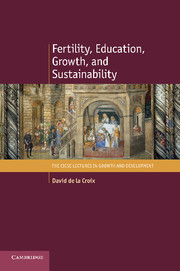Book contents
- Frontmatter
- Contents
- List of figures
- List of tables
- List of symbols
- List of definitions
- List of propositions
- Introduction
- PART ONE DIFFERENTIAL FERTILITY
- PART TWO EDUCATION POLICY
- PART THREE SUSTAINABILITY
- 7 Environmental collapse and population dynamics
- 8 Production, reproduction, and pollution caps
- 9 Population policy
- 10 Conclusion: endogenous fertility matters
- Bibliography
- Author index
8 - Production, reproduction, and pollution caps
from PART THREE - SUSTAINABILITY
Published online by Cambridge University Press: 05 December 2012
- Frontmatter
- Contents
- List of figures
- List of tables
- List of symbols
- List of definitions
- List of propositions
- Introduction
- PART ONE DIFFERENTIAL FERTILITY
- PART TWO EDUCATION POLICY
- PART THREE SUSTAINABILITY
- 7 Environmental collapse and population dynamics
- 8 Production, reproduction, and pollution caps
- 9 Population policy
- 10 Conclusion: endogenous fertility matters
- Bibliography
- Author index
Summary
In the previous chapter we have seen that, in the absence of coordination, the interactions between individual choices may lead to an unsustainable outcome. The objective of environmental policies is to make agents internalize the effect of their behavior on the environment. Under a Kyoto type of regime, the main motivation for capping greenhouse gas emissions arises from a concern for future generations. The aim is to make sure that the climatic conditions they will experience either will not be worse than ours or, at the very least, will not prevent them from leading a decent life.
In the literature on environmental policy, population is considered as exogenous – not necessarily constant, but exogenous, following, for example, some predetermined path provided by forecast agencies or demographers (see e.g. the projections of Lutz et al. (2001) predicting the end of population growth). It means that there is no feedback from policy to population. This might be a good approximation in the short run, but these studies often deal with horizons of one or two centuries, over which population obviously has time to change. In this chapter, we deal with environmental policies when population is endogenous. We will show that environmental policies that restrict pollution have an unintended consequence of population boost, which in turn lowers the effectiveness of the original policy. Hence, the endogeneity of fertility is important when we deal with environmental policy. In short, pollution quotas act as a tax on production of goods which generate pollution.
- Type
- Chapter
- Information
- Fertility, Education, Growth, and Sustainability , pp. 184 - 204Publisher: Cambridge University PressPrint publication year: 2012



